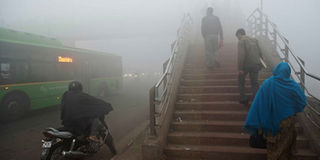India capital is world’s dirtiest city

In this photograph taken on January 31, 2013, Indian commuters use a footbridge as vehicles pass by in New Delhi. India's air-monitoring centre on May 8, 2014, dismissed data released by the World Health Organisation that showed New Delhi's air as the dirtiest in the worldwide, saying the finding was biased and misleading. AFP PHOTO/PRAKASH SINGH/FILES
What you need to know:
- Airborne particles are also associated with increased rates of chronic bronchitis, lung cancer and heart disease.
NEW DELHI, Thursday
New Delhi is the dirtiest city worldwide, a World Health Organisation report has revealed.
A study of 1,600 cities across 91 countries released by WHO showed Delhi had an annual average concentration of airborne small particles of less than 2.5 micrometres in diameter, known as PM 2.5, of 153.
This was almost three times as high as the reading for Beijing of 56 despite the Chinese capital’s reputation for smog, and 10 times that of London.
But India denied the reports and accused WHO of bias.
“We have data for New Delhi which is not biased,” Gufran Beig from the state-run System of Air Quality Weather Forecasting and Research (SAFAR) told AFP.
“It takes into account the data taken from 10 air quality monitoring stations spread around the capital in an unbiased way. It is not misleading,” Beig said.
MONITORING STATIONS
The WHO used data for New Delhi from 2010 to 2013 from five monitoring stations in residential and other areas.
The data from China, where authorities are under pressure to be more transparent about pollution, was from 2010, the last year for which figures were available.
“We are now studying the data for 2011-14 which we have procured from the US embassy in Beijing. This will help us arrive at a more accurate comparison,” Beig said.
The WHO stressed that its new air pollution database, which relies mainly on data gathered by the cities themselves, did not aim to rank cities.” PM2.5 particles are very small in size and can easily enter the body and interfere with the functioning of the lungs.
They are also associated with increased rates of chronic bronchitis, lung cancer and heart disease.




